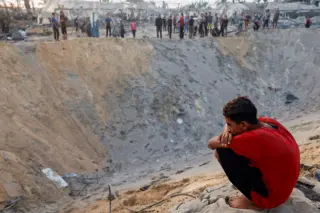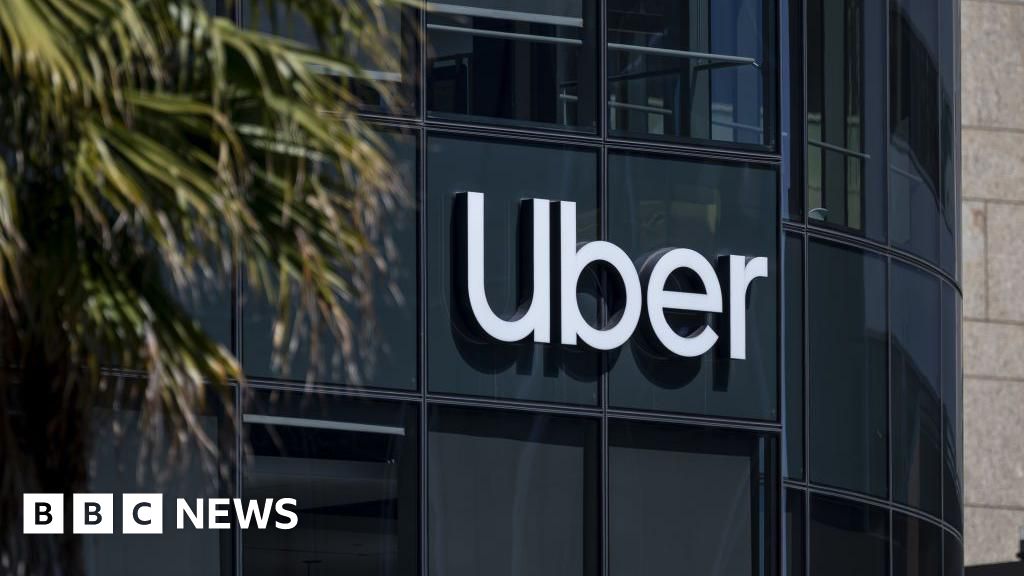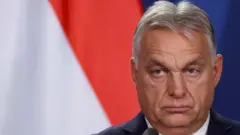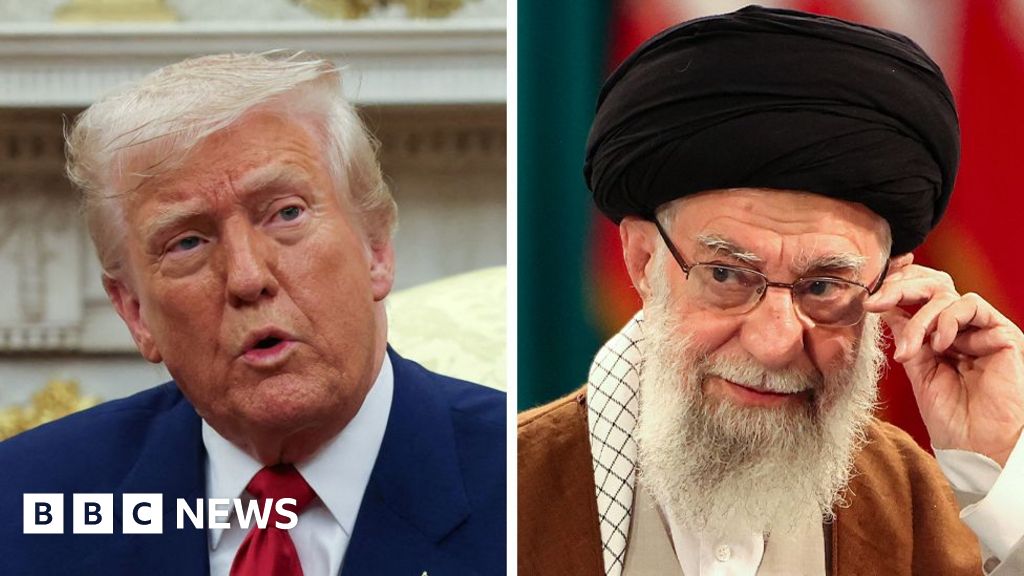 Reuters
ReutersAt least 19 people have been killed in an overnight Israeli strike in the designated humanitarian zone in southern Gaza, the Hamas-run health ministry says.
Witnesses said the strike obliterated an area crowded with tents for displaced Palestinians in al-Mawasi, south-west of Khan Younis, leaving huge craters in the sand.
“The bombing was incredibly intense. People were thrown into the air,” one displaced man told the BBC. “You can’t imagine the devastation.”
The Israeli military said its aircraft attacked what it called “a number of senior Hamas terrorists” operating there – a claim Hamas denied.
The military also disputed the initial death toll put out by the Hamas-run Civil Defence authority, which reported that rescue teams had recovered more than 40 bodies.
Hundreds of thousands of people have sought shelter in the humanitarian zone – which spans only about 41 sq km (16 sq miles) along Gaza’s southern Mediterranean coast – after being told by the Israeli military to evacuate there for their own safety over the past 11 months.
Living conditions inside the area are dire. The UN says it lacks critical infrastructure and basic services, while aid provision is limited due to access and security issues.
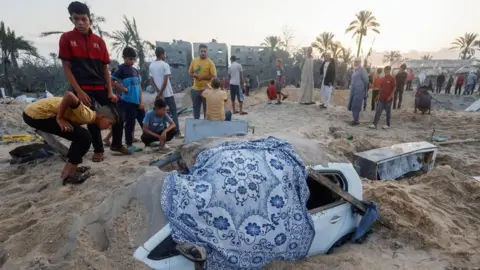 Reuters
ReutersEyewitnesses said large explosions rocked al-Mawasi shortly after midnight local time on Tuesday (21:00 GMT on Monday).
Khaled Mahmoud, a volunteer for a charity who lives near the site of the strike, told the BBC that he had been stunned by the scale of the destruction. “The strikes created three craters 7m [23ft] deep and buried more than 20 tents,” he said.
Aya Madi, a displaced mother of seven from the southern city of Rafah, told a freelance journalist working for the BBC: “We woke up to nothing but sand and fire.
“My children were screaming, and the tent collapsed on them. I pulled them out from under the rubble.
“I held my two-month-old son, thinking he was dead, covered in sand, barely breathing. I washed him and thanked God he was still alive.”
She said all of those killed were civilians, adding that there was “not a single resistance fighter”.
“All that remains is dust and ashes,” she added. “Some of [the casualties] were torn in parts, other they had to dig to find, some were found in people’s houses… The scene is terrifying.”
Saib, a 12-year-old boy from Bani Suheila, told BBC Arabic that “the screams of people filled the place” after the explosions stopped.
“I rushed with my father to help the people and put out the fire. We put out the fire with sand and then we entered the tents where we found burned children and people torn to pieces,” he said.
“This is the first time since the war began that I have seen such horrific scenes.”
Another woman, Aisha Nafi al-Shaeri, said: “It was all tents of displaced people. And now everything is destroyed.”
“They told people to stay here, but there is no safe area,” she added. “They didn’t warn anyone. Everyone was sleeping, and suddenly they started shelling.”
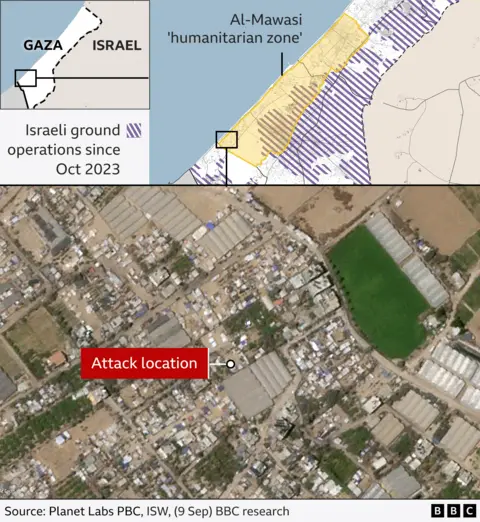
The Civil Defence’s operations director said overnight that more than 40 people were killed and more than 60 others were injured.
Later on Monday, the nearby Nasser hospital in Khan Younis said 13 people killed in the strike had been brought there.
An emergency physician at the hospital, Dr Mohammed al-Qudra, told BBC Arabic that it was also treating 60 injured people, 40 of whom were in a critical condition. “Most of the injuries that arrived at the hospital were third-degree burns and amputations,” he said.
He also warned that the hospital lacked medical equipment and supplies to treat them, and that there was even a shortage of sheets for their beds.
In the afternoon, the Hamas-run health ministry said in a statement that hospitals had received a total of 19 bodies and more than 60 wounded people, some of whom were in a serious condition. It did not say how many were men, women or children.
Rescuers were unable to reach a number of other victims still buried under sand and rubble, or on roads, the ministry added.
In a statement, the Israel Defense Forces (IDF) said aircraft had conducted “a precise strike on a number of senior Hamas terrorists who were operating within a command and control centre embedded inside the humanitarian area”.
They included Samer Abu Daqqa, head of Hamas’s aerial unit, and Osama Tabesh, head of the observation and targets department in Hamas’s military intelligence headquarters, it added.
“Prior to the strike, extensive intelligence gathering was conducted, as well as continuous aerial surveillance in the hours leading up to the strike, which confirmed the presence of the terrorists in the area alongside additional terrorist operatives,” it said, adding that casualty numbers put out by Hamas-run authorities did “not align” with its information.
The IDF accused Hamas of embedding its operatives and military infrastructure in the humanitarian zone and using civilians as human shields.
A Hamas statement denounced the strike on al-Mawasi as a “heinous massacre” and rejected the IDF’s claim that it had a command centre there.
“This is a clear lie that aims to justify these ugly crimes. The resistance has denied several times that any of its members exist within civilian gatherings or use these places for military purposes,” it said.
UN Middle East peace envoy Tor Wennesland condemned the strike on a densely-populated area where displaced people were sheltering.
“I underline that international humanitarian law, including the principles of distinction, proportionality, and precautions in attack, must be upheld at all times,” he said. “I also emphasize that civilians must never be used as human shields.”
He also urged Israel and Hamas to immediately agree a deal that would for a ceasefire and the release of the remaining hostages in Gaza.
The Israeli military launched a campaign to destroy Hamas in response to the group’s unprecedented attack on southern Israel on 7 October, in which about 1,200 people were killed and 251 others were taken back to Gaza as hostages.
More than 40,980 people have been killed in Gaza since then, according to the territory’s Hamas-run health ministry.
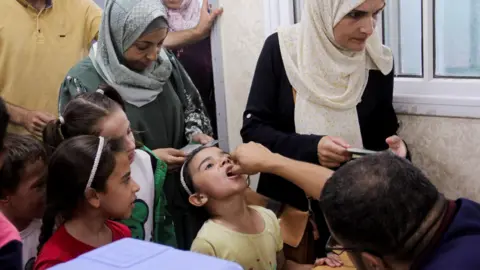 Reuters
ReutersAn estimated 1.9 million people – more than 80% of the population – are estimated to have been displaced by the war, and some have had to flee as many as 10 times.
UN agencies and their partners are currently trying to stop the spread of polio in the overcrowded camps with poor sanitation where many of them are living.
The World Health Organization said the third phase of its vaccination campaign began in northern Gaza on Tuesday, after 446,000 children were inoculated in the centre and south earlier this month during localised pauses in the fighting agreed by Israel and Hamas.
On Monday, a team of 12 UN staff members on their way to the north to support the campaign was stopped by Israeli troops at a checkpoint for more than seven hours, according to UN Humanitarian Co-ordinator Muhannad Hadi.
“While at the checkpoint the team was informed that the IDF wanted to hold two of the UN staff members in the convoy for further questioning,” he said.
“The situation escalated quickly, with soldiers pointing their weapons directly towards the convoy personnel. Live shots were fired, and tanks and bulldozers approached, engaged with, and damaged UN vehicles, endangering the lives of UN staff inside the vehicles.”
The two staff were eventually questioned and then released following the intervention of senior UN officials to de-escalate the situation, he added.
The IDF said its forces had intelligence that a number of Palestinian suspects were present in the convoy, and that they delayed the convoy in order to question them.
Additional reporting by Thomas Mackintosh in London
